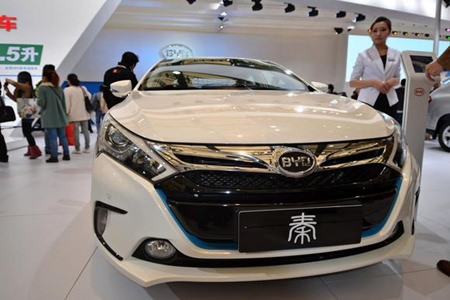There are still those people around who believe the average Chinese adult rides a bicycle. Sorry, the average Chinese adult now drives a motor car, pays purchase tax to buy the car and is paying a 10 percent levy on the prevalue-added-tax price of a car. A car that sells for 100,000 yuan including the value-added tax, would cost the buyer an extra 8,547 yuan (almost 45,000 baht).
However, the Chinese government is aware of its air pollution problem, and as part of the awareness campaign, starting this month, buyers of government-approved electric vehicles and plug-in hybrids will not have to pay this extra tax, according to China’s Ministry of Industry and Information Technology and the State Administration of Taxation.
 BYD EV
BYD EV
To show just how far down the line the Chinese automakers really are, there are 113 models that qualify for the tax exemption. The list includes the e6 from Guangdong Province’s BYD Auto (Build Your Dream partly owned by Warren Buffet) and the Roewe E50 (pronounced “Rover”) of Shanghai-based SAIC Motor. In all, 17 passenger electric vehicles from 11 automakers are covered by the program. As for plug-in hybrids, the tax exemption applies to six models from four carmakers. The program also covers electric and plug-in hybrid buses and trucks.
Four years ago, Beijing began subsiding purchases of electric vehicles. With the tax exemption combined with a local government subsidy, car buyers can save up to 100,000 yuan off the price of these cars. Now a BYD e6, which would otherwise go for about 310,000 yuan, can be had for about the same amount as a Toyota Camry or Honda Accord, midsize sedans that are made in China by joint ventures.
Sales of these so-called “green” vehicles have been rising recently. In the January-June period, they increased 120 percent on the year, to the range of 20,000 units, according to industry data. In a bid to further boost these numbers, Chinese President Xi Jinping in May visited a research and development lab of SAIC Motor in Shanghai and stated that the development of next-generation eco-friendly vehicles “is essential for making China an auto giant.”
In July, the State Council recommended that eco-friendly cars make up at least 30 percent of vehicles purchased by local governments and public transportation authorities.
With the July recommendation, which says local government bureaucrats will be assessed by how many eco-friendly vehicles they put into use and by how many charging stations they manage to install. The Shanghai municipal government appears to have taken notice. It has decided to introduce 13,000 eco-friendly cars by 2015.
It is estimated that if these and other local governments do their part, they could end up buying 80,000 eco-friendly cars in 2014 and 250,000 in 2015. In doing so, they could provide a much-needed boost to China’s sluggish eco-friendly car market.




